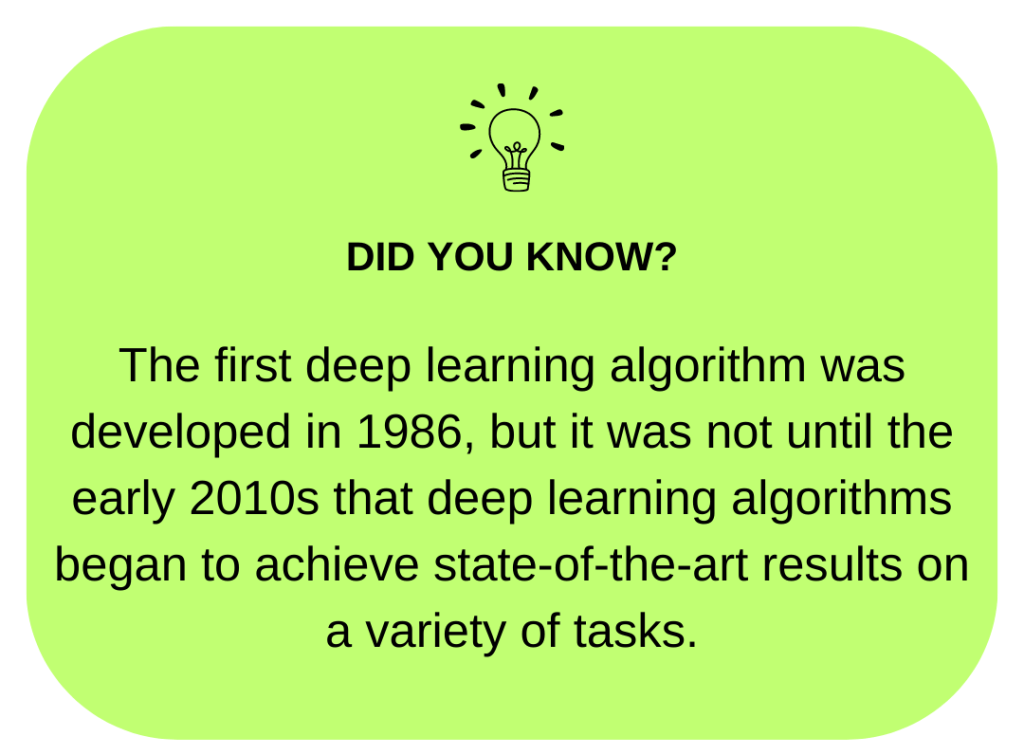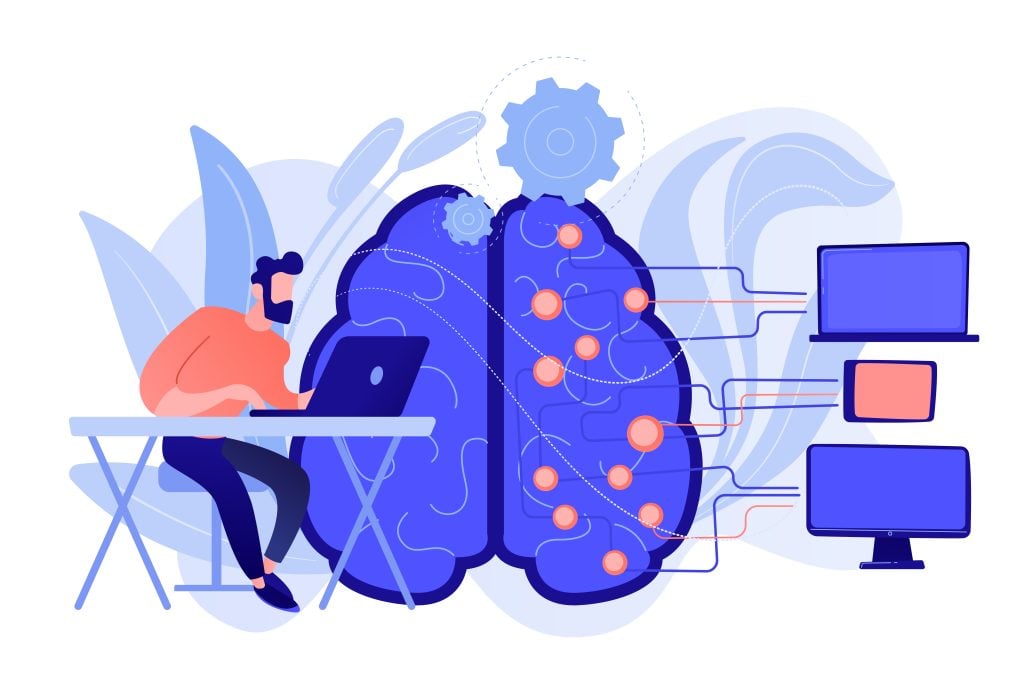TL;DR:
Deep learning is a specialized branch of machine learning that mimics the human brain using artificial neural networks. It enables computers to learn from vast amounts of data, recognizing patterns and making intelligent decisions.
Key Points:
- Neural Networks & Layers: Uses multiple layers to process and refine information, enabling complex decision-making.
- Machine Learning vs. Deep Learning: Deep learning is a subset of machine learning that excels at handling large-scale, unstructured data.
- Advantages:
- Automates feature extraction, reducing the need for manual data processing.
- Handles massive datasets efficiently (big data applications).
- Learns complex patterns for improved accuracy in AI-driven tasks.
- Adapts to new tasks using transfer learning and fine-tuning.
- Supports automation in industries like healthcare, finance, and cybersecurity.
- Applications:
- Image & Speech Recognition (facial recognition, voice assistants).
- Natural Language Processing (machine translation, chatbots).
- Medical Diagnosis (disease detection in medical images).
- Autonomous Vehicles (self-driving cars).
- Financial Trading & Fraud Detection.
- Creative AI (art, music, text generation).
- Challenges & Ethics: Bias in training data, potential misuse, and the need for responsible AI development.
Deep learning is revolutionizing AI, unlocking new possibilities across industries. As the field evolves, mastering deep learning will be crucial for staying ahead in the AI-driven world.
What is Deep Learning?
Deep learning is a neat way that helps computers learn from lots of information. It’s a kind of machine learning, but it’s special because it works a lot like our brains. You can think of your brain as a big network where information gets bounced around. That’s what deep learning does, but with computers.
This network is made up of layers. Each layer makes the information clearer. This helps the computer spot patterns and details from the information, just like we do.
Here are some of the key features of deep learning:
- Artificial neural networks: Deep learning algorithms are based on artificial neural networks, which are inspired by the human brain. Artificial neural networks are made up of interconnected nodes, or neurons, that work together to learn and process information.
- Multi-layer architecture: Deep learning algorithms typically have a multi-layer architecture, with each layer of neurons learning a different level of abstraction from the data. This allows deep learning algorithms to learn complex patterns and relationships in data that would be difficult to learn with traditional machine learning methods.
- Data-driven: Deep learning algorithms are data-driven, meaning that they learn from data. This makes them very versatile and can be applied to a wide range of problems.
- Scalable: Deep learning algorithms are scalable, meaning that they can be used to process large amounts of data and make predictions in real time.
As we delve into the advantages of deep learning, keep in mind that this technology’s ability to automatically learn and adapt from data is what underpins its transformative power. By understanding the core principles of deep learning, we can better appreciate how it has reshaped the AI landscape and unlocked innovative solutions across various industries.
Does Deep learning and Machine Learning Go Hand in Hand?
Yes, machine learning and deep learning are closely related. Deep learning is a type of machine learning that uses artificial neural networks to learn from data. Neural networks are inspired by the human brain, and they are able to learn complex patterns and relationships in data. Machine learning is a broader term that encompasses many different approaches to making machines learn, including deep learning.
Machine learning and deep learning can be used together to achieve better results than either approach can achieve on its own. For example, a deep learning model can be used to learn the features of an image, and then a traditional machine learning model can be used to classify the image based on those features.
As the field of machine learning continues to evolve, we can expect to see even more innovative ways to use these two powerful technologies together.

What are the Advantages of Deep Learning?
- Unmatched Performance in Complex Tasks
Deep learning models, especially neural networks with multiple layers, excel in handling complex tasks because they are able to learn complex patterns and relationships in data. This is due to the way that deep learning models are structured.
Neural networks are made up of interconnected nodes, or neurons, that work together to learn and process information. The more layers a neural network has, the more complex the patterns and relationships it can learn.
This makes deep learning models ideal for tasks such as image and speech recognition, natural language processing, and autonomous driving.
- Feature Extraction and Representation Learning
Deep learning algorithms can automatically learn relevant features from raw data, reducing the need for manual feature engineering. This is achieved through the use of neural networks with multiple layers, where each layer extracts a progressively more complex representation of the input data.
In traditional machine learning, feature engineering involves manually selecting and extracting relevant features from the raw data. This can be a time-consuming and expensive process, and may require domain expertise. Deep learning, on the other hand, can automatically learn relevant features from the data, reducing the need for manual feature engineering.
- Handling Large-Scale Data
Deep learning models can efficiently process and learn from massive datasets, making them suitable for big data applications. Instead of relying on manual feature engineering, deep learning models can automatically extract relevant features from raw data, enabling them to learn from vast amounts of data. This is achieved through the use of neural networks with multiple layers, where each layer extracts a progressively more complex representation of the input data.
One of the key advantages of deep learning models in handling large-scale data is their ability to scale horizontally across multiple machines or clusters. This enables them to process massive datasets quickly and efficiently, making them suitable for big data applications. Additionally, deep learning models can be trained using parallel processing techniques, which further improves their performance and reduces the time required for training.
- Continual Learning and Adaptability
Deep learning models demonstrate adaptability to changing scenarios through techniques like transfer learning and fine-tuning. Transfer learning involves leveraging pre-trained models and adapting them to new tasks, while fine-tuning involves adjusting the pre-trained model to a new task by tweaking its parameters. These techniques allow deep learning models to learn from previously seen data and adapt to new data, making them more flexible and adaptable to changing scenarios.
This adaptability leads to reduced retraining and faster model deployment. Instead of starting from scratch, transfer learning and fine-tuning enable the use of existing pre-trained models, significantly reducing the amount of training data required and the time and resources needed for training. This leads to faster deployment of models and quicker adaptation to changing scenarios.
- Improved Decision Making and Prediction
Deep learning enhances decision-making processes through accurate predictions based on patterns and historical data. By analyzing large amounts of data and identifying patterns, deep learning models are able to make predictions with high accuracy, enabling better
This is particularly useful in industries like marketing, stock trading, and manufacturing, where accurate predictions can lead to significant improvements in performance and profitability.

- Automation and Efficiency
Deep learning contributes to automation by performing tasks that would otherwise require human intervention. By leveraging large amounts of data and identifying patterns, deep learning models are able to automate a wide range of tasks, from customer support to industrial process optimization. This leads to increased efficiency, reduced costs, and improved performance in a variety of industries.
Examples like chatbots, customer support automation, and industrial process optimization demonstrate how deep learning models can improve efficiency, reduce costs, and improve performance in a variety of industries. By leveraging large amounts of data and identifying patterns, deep learning-powered automation is transforming the way we work and improving our ability to deliver value to customers.
- Handling Unstructured Data
Deep learning models can process unstructured data like images, audio, and text, extracting valuable insights from diverse sources. Unstructured data is data that does not have a pre-defined data model or is not organized in a predefined manner, making it difficult to analyze using traditional methods. However, deep learning models can analyze unstructured data by learning patterns and features directly from the data, enabling them to extract valuable insights and make predictions.
- Addressing Complex Problems
Deep learning has the ability to tackle intricate problems that traditional algorithms struggle with. By leveraging large datasets and complex algorithms, deep learning models can identify patterns and features that may be difficult for traditional algorithms to detect. This enables researchers to address complex problems in fields like drug discovery, climate modeling, and genetic research.
- Continuous Improvement through Neural Architecture Search
Neural architecture search (NAS) is a technique for automating the design of neural networks, which are a type of deep learning model widely used in the field of machine learning. The goal of NAS is to create more efficient and effective neural network designs by automating the process of architecture selection.
Traditionally, the architecture of a neural network is manually designed by human experts, who determine the number of layers, the number of neurons in each layer, and the connections between them. However, this process can be time-consuming and may not always result in the optimal architecture for a given task.
NAS, on the other hand, uses algorithms to automatically search for the best neural network architecture based on a given dataset and task. NAS algorithms can use techniques like reinforcement learning, genetic algorithms, and Bayesian optimization to search for the optimal architecture.
- Ethical and Social Considerations
As with any technology, deep learning applications come with potential challenges, biases, and ethical concerns that must be addressed. One of the main challenges is the potential for biased training data, which can lead to biased results and perpetuate existing social inequalities. For example, if a deep learning model is trained on data that is primarily composed of white male faces, it may not be as accurate when identifying faces of people from other racial or gender groups.
Another ethical concern with deep learning applications is the potential for unintended consequences. For example, a deep learning model used to make decisions about job applicants may inadvertently discriminate against certain groups based on factors like race or gender. In addition, there is a risk that deep learning models may be used for malicious purposes, such as creating deep fakes or automating cyberattacks.

What are the Applications of Deep Learning?
- Image recognition: Deep learning is used to develop systems that can identify objects in images. This is used in a variety of applications, such as self-driving cars, facial recognition, and medical image analysis.
- Speech recognition: Deep learning is used to develop systems that can convert spoken words into text. This is used in a variety of applications, such as voice assistants, dictation software, and transcription services.
- Natural language processing: Deep learning is used to develop systems that can understand and process human language. This is used in a variety of applications, such as machine translation, text summarization, and question answering.
- Medical diagnosis: Deep learning is used to develop systems that can diagnose diseases from medical images. This is used in a variety of applications, such as cancer detection and diabetic retinopathy screening.
- Financial trading: Deep learning is used to develop systems that can trade financial assets. This is used to predict market trends and make informed investment decisions.
- Fraud detection: Deep learning is used to develop systems that can detect fraud. This is used in a variety of applications, such as credit card fraud and insurance fraud detection.
- Customer service: Deep learning is used to develop systems that can provide customer service. This is used to answer customer questions, resolve issues, and provide personalized recommendations.
- Creative content generation: Deep learning is used to generate creative content, such as images, music, and text. This is used in a variety of applications, such as generating realistic images for movies and video games, creating music, and writing poems and stories.
- Self-driving cars: Deep learning is used to develop systems that can drive cars without human input. This is a rapidly developing field, and deep learning is playing a key role in the development of self-driving cars.
These are just some of the many applications of deep learning. As deep learning technology continues to develop, we can expect to see even more applications in the years to come.
Final Thoughts
In conclusion, deep learning is a game-changer in the field of artificial intelligence, with its ability to process massive amounts of data and make accurate predictions in real-time. From self-driving cars to personalized marketing, deep learning is transforming industries and opening new opportunities for innovation. With its many advantages, it’s no wonder that deep learning is quickly becoming an essential tool for businesses and researchers alike. So, if you’re looking to stay ahead of the curve in AI, it’s time to dive deep into the world of deep learning.

- What are the challenges in deep learning?
- Deep learning models require a lot of data to train.
- Deep learning models can be computationally expensive to train and deploy.
- Deep learning models can be biased, which can lead to discrimination.
- Deep learning models can be hacked, which can pose a security risk.
- What is an example of deep learning?
- Image recognition is a common example of deep learning. Deep learning models can be trained to identify objects in images, such as faces, cars, and animals.
- Speech recognition is another common example of deep learning. Deep learning models can be trained to recognize spoken words.
- Natural language processing is a third example of deep learning. Deep learning models can be trained to understand the meaning of text and speech.
- Why is deep learning better than neural networks?
Deep learning is a type of neural network, but it is more complex and powerful. Deep learning models can learn more complex patterns and relationships in data than traditional neural networks.
- How is deep learning used in everyday life?
Deep learning is used in a variety of everyday applications, such as:
- Self-driving cars
- Facial recognition software
- Virtual assistants
- Spam filters
- Medical image analysis
- Financial trading
- Recommendation systems
- How does deep learning help students?
Deep learning can help students in a variety of ways, such as:
- Personalized learning: Deep learning models can be used to personalize learning experiences for each student.
- Automatic grading: Deep learning models can be used to grade student assignments automatically.
- Chatbots: Deep learning chatbots can be used to provide students with personalized help and support.
- Virtual labs: Deep learning can be used to create virtual labs that allow students to experiment with different concepts.
- What are the uses of deep learning?
The uses of deep learning are vast and growing. Some of the most common uses include:
- Image recognition
- Speech recognition
- Natural language processing
- Medical diagnosis
- Financial trading
- Recommendation systems
- Self-driving cars
- Virtual assistants
- Spam filters
- Fraud detection
- Drug discovery
- Climate change research
- What is the best of deep learning?
The best of deep learning is its ability to learn complex patterns and relationships in data. This allows deep learning models to solve problems that were previously impossible to solve.
- What are the advantages of machine learning vs deep learning?
Machine learning is a broader term that encompasses deep learning. Machine learning models can be simpler and less computationally expensive than deep learning models. However, deep learning models can achieve better results on certain tasks.
- What are the advantages of deep learning vs traditional image processing?
Deep learning models can learn more complex patterns and relationships in images than traditional image processing techniques. This allows deep learning models to achieve better results on tasks such as image classification and object detection.
- What is the importance of deep learning in points?
Here are some of the key points about the importance of deep learning:
- Deep learning is a powerful tool that can be used to solve a variety of problems.
- Deep learning is still a relatively new technology, but it is rapidly evolving.
- Deep learning has the potential to revolutionize many industries and improve our lives in many ways.
- It is important to be aware of the potential risks of deep learning as well as the potential benefits.
- What is the biggest advantage of deep learning support your answer?
The biggest advantage of deep learning is its ability to learn complex patterns and relationships in data. This allows deep learning models to solve problems that were previously impossible to solve. For example, deep learning models have been used to develop self-driving cars, facial recognition software, and medical image analysis.





